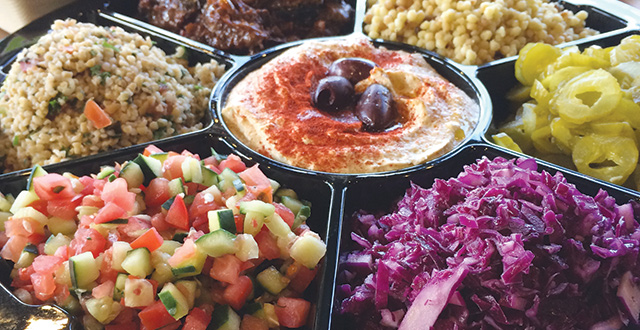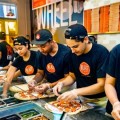Yaniv Benaroya’s restaurateur father gave him two options: go to college or start selling pita. Benaroya, 18 at the time, chose the latter and began his apprenticeship at a bakery that imported all their equipment from Israel, the flatbread and Benaroya’s homeland.
“The quality really got me excited,” he says. “And it was my dream to open a restaurant, so I knew I had to start by learning how to bake and work my way backwards from there.”
When the bakery’s lease expired, Benaroya went to college and invested in real estate, before opening his first Gotta Eatta Pita store in Danville with partner Eric Huber. They now have four locations and hope to double that number in the next year while keeping their brand local to the Bay Area. The pita possesses a supple texture and the smooth exterior of a Japanese pastry, tasting radically different from additive-laden, plastic-wrapped varieties.
“It’s about a four-hour process to make pita bread,” Benaroya says. “It’s ongoing, like making pizza—you don’t premake pizza or pita. We make it all day, fresh with no preservatives. It only has a life of 12 hours. That’s the life of real pita bread.”
Like Chipotle, Gotta Eatta Pita serves bowls or wraps assembly-line style. Customers choose from bright red cabbage, fluffy couscous beads, smoky slow-cooked eggplant, nutty rich hummus and crisp flash-fried falafel. A bowl goes for $10, but it’s food enough for two, and of a quality and quickness that don’t often go together here.
“On every corner in Israel, that’s how food is served,” Benaroya says. “That’s the norm. I would eat it every single day, so that’s how I got connected to this whole thing. I just loved how much quality food you get. You don’t have to wait a minute. That’s the way it should be.”
The staff prepares every morsel from scratch in the open, stainless steel kitchen behind the counter. They clearly know their cuisine, which is a necessity as Mediterranean food comes into the mainstream. While it may have its own aisle in most supermarkets, not everybody knows what those crunchy brown balls are.
“Some people still have no idea what a falafel is,” Benaroya says. “[If not], we automatically give them some, say ‘try this out,’ then tell them what it is.” It’s fried ground garbanzo beans with spices and parsley.
“We’re breaking down barriers,” he continues. “You see people saying, ‘whatever that is, give me that.’”
More info.

 Doppio Zero Pizzeria Napoletana brings Naples one step closer to Silicon Valley
Doppio Zero Pizzeria Napoletana brings Naples one step closer to Silicon Valley  Anthony Bourdain Visits San Jose in New Episode of 'Parts Unknown'
Anthony Bourdain Visits San Jose in New Episode of 'Parts Unknown' 


